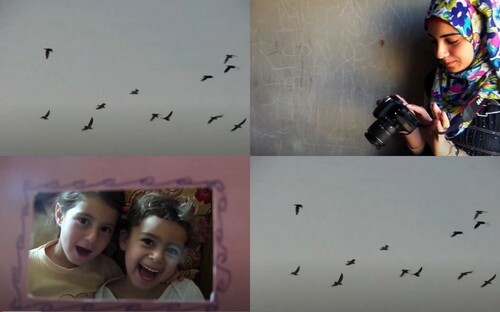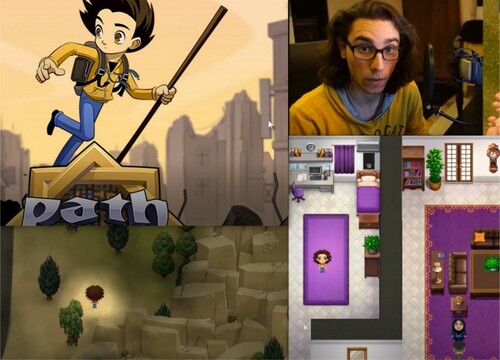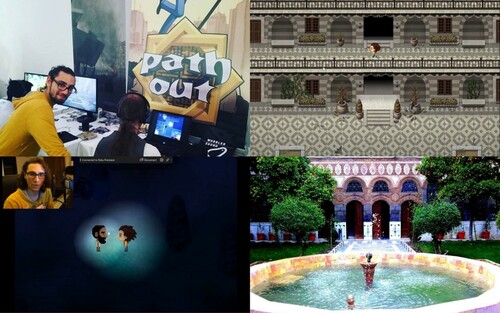ABSTRACT
Narrating my reflections on the quarantine during the COVID-19 pandemic in 2020 and my experience of the crisis in Syria, this paper studies the ways fear can transform into resilience by examining the self-reflexive works Path Out (Causa Creations, 2016) and Another Kind of Girl (You Must know, 2016). Using digital media, the creators of these works of art construct autobiographical, educational, and interactive narratives about coping and belonging in the course of the crisis. I propose viewing both texts as examples of ‘resilient communication’ that reacts to social and cultural issues brought about by crisis and suggests creative solutions that convey optimistic views of the future. Outlining the conventions of resilient communication, in turn, promotes the production of media works that use educational, creative and autobiographical techniques to foster collective resilience.
Introduction: reflections on resilience and fear
‘Scared I am of that the heart trusts in’ (Alshaarani & Arabi, Citation2013). I sit at home in Damascus with this known verse calligraphy hung by roommate Lina on our wall. I sat for days with unreliable, intermittent sources of electricity, water, and heat during a complicated war. Back then, fear could cost me thinking time between hearing explosions and walking in the streets while sleep-deprived to hide from missiles. I lost friends and family. People lived in outdoor gardens and on public sidewalks beside Damascus hospitals. I think of a neighboring picture on the wall: ‘Fear is an infinite number,’ from the poem, Identity. ‘But fear! What is fear?’ (Alhaj, Citation2020). Now, the global pandemic brings back fear. It triggers me. It continuously reminds me of my home's destruction. During this pandemic, I recall past lessons from the Syrian crisis. How can people around the world, who experienced wars, trauma, poverty, death, violence, displacement, discrimination, sickness, and unemployment, live through such a big crisis again?
Many questions surround me. I read a call to write for the Media Rise platform's Quarantine Across Borders series (Ramasubramanian, Citation2020). Writing and publishing my story there enhanced my sense of union with the world in quarantine as well as inspired new ways of coping with the COVID-19 pandemic by studying examples of resilient communication. In this essay, I explore the ways displacement and confinement generate fear and resilience by examining the self-reflexive works of two Syrian artists who use digital media to craft art out of personal emotions and experiences. Using alternative filmmaking and videogaming, these artists produce resilient communication about coping and belonging at difficult times.
What I learned from the COVID-19 pandemic here in the US and the war that I witnessed in Syria, is that a resilient form of communication is a powerful tool that is useful for bringing attention to contemporary social crises. During the lockdown, it is useful to link discourses of resilience surrounding COVID-19 to global media examples that similarly deal with crises and fears, while demonstrating resilience in their form and content.
The communication theory of resilience generally explains how people utilize resources to constitute the new normal of their lives after disruption, loss, trauma, and disaster (Buzzanell, Citation2017). Connotations of ‘resilience,’ however, can differ from one context to another. For example, networking and data studies discuss resilience as a form of community support following cyber bias and discrimination (Jakubowicz et al., Citation2017). Meanwhile, in participatory theater, resilience takes on the form of interaction, empathy, and experience that solves conflicts and social problems (Brown et al., Citation2017). Perhaps, most prominently, the term appears within feminist discourses, which emphasize interaction and communication. In this context, resilience is a process of relational and rhetorical engagement that does not necessarily return an individual life to equilibrium following disruption but entails an ongoing responsiveness, never complete nor predetermined. It is transformative in the sense that it changes the way a life is lived. Resilient living involves determination, perseverance, hope, and imagination (Flynn et al., Citation2012, pp. 1–7). Drawing on some of these ideas, I propose that resilience itself can be communicable through forms of media. I use the term ‘resilient communication’ to designate media that responds to current social or cultural problems and suggests solutions that convey an optimistic view of the future. Resilient communication is strongly connected to its makers and their personal experiences, helping both artist and audience cope with the crisis. It addresses the audience directly either through the narrative or via interactive digital storytelling techniques. Autobiography, edutainment, and encoded empathy are some of its defining narrative conventions.
Resilient communication using art in applied contexts of documentary and videogaming
The lockdown pushes me to revisit two artists that cultivate resilient communication, basing it on their experiences during the war. Throughout the Syrian crisis, being resilient often meant resuming work and mundane activities after being exposed to traumatic events. My own experience leads me to think of resilience as a means of achieving peace by rebuilding and maintaining civil society. Resilient communication can also be seen as a recovery of collective memories through storytelling. It should be produced mindfully and reflect the ways we can move past collective trauma and reconstruct our narratives. I appreciate people's endurance even as I mourn divided Syria. I recall visiting friends in Damascus, who welcomed me into their home. We watch and laugh at the funny animated TV series SpongeBob SquarePants (Hillenburg & Tibbitt, Citation1999-Citation2020). We play games on the Wii, dance, and sing. For a moment, I forget what is happening outside. I realize now that such media can effectively facilitate their audiences’ and makers’ resilience during difficult times.
After the war began, the young girl Khaldiya Jibawi expressed her resilience by filming her new life in a refugee camp in Jordan. She turned herself into a teacher to educate other kids in the camp. In her documentary, Another Kind of Girl (You Must Know, Citation2016), she recalls her arrival at the camp when she heard children crying all the time and depicts what seems like a state of collective fear. She says, since then, things have changed. She does not know how, but she has become what she describes as a ‘brave girl.’ The film reminds me of people in the streets of Damascus doing their work and errands as though nothing has happened. Though I am not an advocate for going into the streets when it is dangerous, their bravery and unstoppable desire to fully live their lives impress me and inform my current understanding of resilience.
There are numerous sensationalized media stories about refugees. However, Khaldiya's film is her own personal response to anger and she says filmmaking makes her comfortable. A significant aspect of her work is that it delivers a message through the lens of citizen journalism. She is controlling the gaze and telling the story from a different perspective. Her case exemplifies how displaced artists can document and narrate their own personal stories. Their Guerrilla films, with low production values and focus on real events and settings, reflect more subjective, authentic, and honest experiences. There are details in such films, in their ‘weird corners’, as Khaldiya calls them, that we do not see in mainstream media. The setting of Khaldiya's film is a dreary refugee camp. The UNHCR tents swaying in the wind construct a sad atmosphere, but Khaldiya's playful tone as a narrator, the images of playing children, the flying birds and shining sun convey an optimistic message. Here, I bring our attention to how this alternative mode of production can express resilience. This short story narrates the transformation from the sound of crying and fear to the initiative of teaching, recording video, and storytelling. The moment Khaldiya started recording, she shifted herself from a victim to a resilient storyteller and creator ().
Figure 1. A collage of screencaps from Another Kind of Girl (You Must Know, Citation2016).

Another autobiographical example worth highlighting belongs to the realm of digital art. Co-designed by Georg Hobmeier, the founder of Causa Creations, Path Out (Causacreations, Citation2016) is an independent free-to-play videogame that tells the story of developer Jack Gutmann née Abdullah Karam, who arrived as a refugee in Europe from Syria. Though coming from a country, where videogame production is exceedingly rare, he successfully co-developed an educational game that I consider to be a work of art. When we discussed Path Out, Gutmann told me that videogaming for him is not mere playing but also educational and artistic. While it constitutes a complete title in and of itself, Gutmann views it as a prologue to or a demo for a larger project. So, I highlighted Path Out as diasporic media art and pedagogic digital model that reacts to the crisis. To connect the readers with the maker, I interviewed Gutman in Fall 2019 and have included a link to clips from the interview in the bibliography of this article, like Khaldiya, Gutmann uses autobiography as a pedagogical technique of reconstructing memory and belonging, while developing resilience in response to displacement and fear ().
Figure 2. Collage of photos from Path Out (Causa Creations, Citation2017).

The history of digital pedagogy and educational video games started with the beginning of digital media and computing. The example of Path Out can be discussed in terms of critical video games studies. In Queer Game Studies: What is Queerness in Games, Anyway?, Naomi Clark explains how games, with their exciting digital existence, could be deployed for many goals. Some examples are Games for Change Movement and Jane McGonigal's applications of psychological reinforcement, motivated physical exercise, and learning about public libraries (Clark, Citation2017, p. 11). Two of the most interesting examples that utilize gameplay for productive and political ends are SuperStruct (2007) and World Without Oil (2007). Both alternate reality games instruct teachers on how to format class lessons and apply games in classrooms (McDowell & Eklund, Citationn.d.b). World Without Oil invites the players to envision how an oil shortage problem would affect their lives and how they would react to its various stages (McDowell & Eklund, Citationn.d.a.). SuperStruct predicted global issues that would arise in 2019, such as generation exile and quarantine (Fandom, Citation2020). Communities of players collaborated across social media to develop potential future solutions. SuperStruct is unique in its futuristic sensitivity and its relation to the current COVID-19 and displacement crises.
The designer plays on the stereotypes that usually represent the Middle East in mainstream video games. Johan Höglund (Citation2008) explains how military-industrial-media-entertainment renders the Middle East as a site of constant war and the gamer as a soldier willing to fight and even support the ideology that functions as the games’ political rationale. Gutmann opposes Middle Eastern and Arab misrepresentation in war games by providing edutainment that represents the individual, who refuses the war.
I see Path Out as a pedagogical game that contemplates fear of war and the refugee trip in an entertaining form. It aims to enlighten audiences about the urgent problem of displacement and trauma by teaching empathy. It humanizes what we see on the news and transfers the information about the Syrian crisis to other levels of discussion through digital art and entertainment. Path Out not only addresses humanitarian issues but also involves the displaced creator who narrates the story. His resilience, as a Syrian refugee, transfers his fear and images of his home's destruction into creativity.
I asked Gutmann about the target audience of this game. He said, ‘we are very specific and picky with that, so our target would be something hard to find in this day and age, and that is a human being with empathy’ (7Gates, Citation2020). When I asked him about the challenges of working in such an industry, Karam refers to many difficulties. In particular, he notes that it is hard to produce a political work, as ‘the companies would tell you that the subject is just too heavy for their portfolio’ (7Gates, Citation2020). However, he believes that urgent topics like the refugee crisis within this medium can be successful and supported by media coverage.
Gutmann crossed the borders himself and created a work of art about his story, calling to mind Naficy's concept of ‘accented cinema,’ which tends to narrate the personal experiences of a filmmaker, who appears within the diegesis as a character with the ability to cross borders and cultures. This ability stems from the familiarity with the cultural and legal codes of interacting cultures (Naficy, Citation2001, pp. 10–39). Gutmann can be considered an accented video game designer and his work – an example of an accented video game or accented digital storytelling. I agree with Gutmann on the benefits of exploiting the mass appeal of video games to educate audiences and transfer fear into creative crisis management. Referencing Path Out, he said,
When you play a game, you switch your perspective. You will get the perspective of the character. You want to know the story. It is suddenly different from the news. You feel you can understand what they are going through using the fictional experience and imagining how it is in reality. These are one of the things games could do. (7Gates, Citation2020) ()
This creative work invites me to think of Henry Giroux’ criticism of pedagogy. He states, ‘young people are now openly treated as customers and clients rather than a civic resource, while much poor youth are simply excluded from the benefits of a decent education through the implementation of zero-tolerance policies’ (Giroux, Citation2011, p. 8). Edutainment films and videogames are indeed commercially popular today; however, my goal in using such media examples is to invite young people to critically engage with such media. These examples connect the youth with the production process by saying indirectly that young people can transform fear into resilience and creativity. And Gutmann's resilience for me is the line he crossed from fear and displacement to creative digital storytelling.
Figure 3. A collage of photos from Path Out (Causa Creations, Citation2017; Mezzofiore, Citation2020; 7Gates, Citation2020).

Contemplating the lessons of resilience over fear
These examples of resilient communication that I have examined respond in creative ways to the Syrian crisis. Gutmann decides to withdraw from the complicated war. Khaldyia teaches children at the camp. Both of them use media to produce creative works that deal with larger social and cultural problems while helping them cope with their traumas. Engaging with these works can be potentially therapeutic for those who have had similar experiences. Audiences of these works are invited to connect with the makers, empathize with them and draw on their optimistic perspectives to cope better with crises. By highlighting the issue of fear and displacement, media producers are promoting collective resilience.
Again, the vivid memories of my roommate Lina, her consciousness, and wall pictures come back. I am impressed by how much she lives in the moment. We talk without mentioning war stories even when war occupies my thoughts. Thinking of people like Lina, Gutmann, and Khaldiya helps strengthen my coping techniques during the quarantine. Syrians possess an astonishing stubbornness to prettify every day. During the crisis of COVID-19, I am also amazed by the endurance of the frontline workers in the US who much like Lina, Jibawi, and Gutmann have their own stories of resilience, many of which remain invisible or untold. To help society move on from COVID-19, instructors and theorists can help others learn to tell their stories and produce resilient communication. Doing so will help us heal when similar crises occur in the future.
Disclosure statement
No potential conflict of interest was reported by the author(s).
References
- Alhaj, U. (2020). Identity poem by Unsi Alhaj | Poetry قصيدة هوية للشاعر أنسي الحاج | ديوان الشعر.DiwanDB.com. Retrieved July 10, 2020, from https://www.diwandb.com/poem/%D9%87%D9%88%D9%8A%D8%A9.html
- Alshaarani, M., & Arabi, I. (2013). Mouneer Alshaarani منير الشعراني- Posts. Facebook. https://www.facebook.com/153316014743719/photos/a.321689127906406/476482482427069/?type=3&theater
- Brown, K., Eernstman, N., Huke, A., & Reding, N. (2017). The drama of resilience: Learning, doing, and sharing for sustainability. Ecology and Society, 22(2), 8. https://doi.org/10.5751/ES-09145-220208
- Buzzanell, P. (2017). Communication theory of resilience: Enacting adaptive-transformative processes when families experience loss and disruption. In D. Braithwaite, E. Suter, & K. Floyd (Eds.), Engaging theories in family communication: Multiple perspectives (2nd ed., pp. 98–109). Taylor and Francis. https://doi.org/10.4324/9781315204321-9
- Causa Creations. (2016). Path out [Video game]. https://causacreations.net/portfolio/path-out/
- Causa Creations. (2017). Path Out on Steam. https://store.steampowered.com/app/725980/Path_Out/
- Clark, N. (2017). What is queerness in games, anyway? In B. Ruberg & A. Shaw (Eds.), Queer game studies (pp. 3–14). University of Minnesota Press.
- Fandom. (2020). Superstruct Wiki. Retrieved March 22, 2020, from https://superstruct.fandom.com/wiki/Superstruct_Wiki
- Flynn, E. A., Sotirin, P., & Brady, A. (2012). Introduction: Feminist rhetorical resilience – possibilities and impossibilities. In E. E. A. Flynn, P. Sotirin, & A. Brady (Eds.), Feminist rhetorical resilience (pp. 1–29). University Press of Colorado. https://doi.org/10.2307/j.ctt4cgpws.3
- Giroux, H. A. (2011). On critical pedagogy (1st ed.). Continuum.
- Hillenburg, S., & Tibbitt, P. (1999–2020). SpongeBob SquarePants [TV series]. United Plankton Pictures, Nickelodeon Animation Studio. https://www.metacritic.com/tv/spongebob-squarepants/season-1/episode-41-mermaid-man-and-barnacle-boy-ii
- Höglund, J. (2008). Electronic empire: Orientalism revisited in the military shooter. Game Studies, 8(1). http://gamestudies.org/0801/articles/hoeglund
- Jakubowicz, A., Dunn, K., Mason, G., Paradies, Y., Bliuc, A.-M., Bahfen, N., Oboler, A., Atie, R., & Connelly, K. (2017). Cyber racism and community resilience strategies for combating online race hate. https://doi.org/10.1007/978-3-319-64388-5
- McDowell, D., & Eklund, K. (n.d.a). Lesson one: World without oil. Writerguy. Retrieved July 6, 2020, from http://writerguy.com/wwo/metalesson1s.htm
- McDowell, D., & Eklund, K. (n.d.b). Lesson plans: World without oil. Writerguy. Retrieved March 15, 2020, from http://writerguy.com/wwo/metateachers.htm
- Mezzofiore, G. (2020). Retro-style game about Syrian refugee’s experience will make you laugh and cry. Mashable. Retrieved November 23, 2020, from https://mashable.com/2017/08/07/syrian-refugee-path-out-16-bit-rpg/
- You Must Know. (2016, June 18). Another Kind of Girl #SHORT DOCUMENTARY #YMK9. [Video]. YouTube. https://www.youtube.com/watch?v=r0yXZzDXpCI
- Naficy, H. (2001). An accented cinema: Exilic and diasporic filmmaking (pp. 10-39). Princeton University Press.
- Ramasubramanian, S. (2020). Convener’s note: Media rise’s quarantined across borders collection. https://oaktrust.library.tamu.edu/handle/1969.1/188262
- 7GATES. (2020, November 2023). Reviewing Path Out & interview with Jack Gutmann: Video gaming the refugee trip #7GATES.
